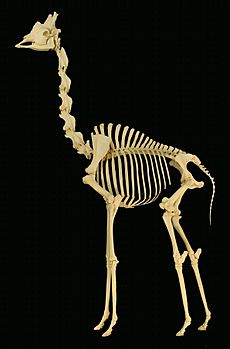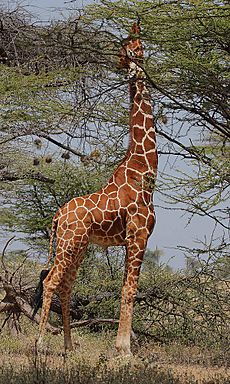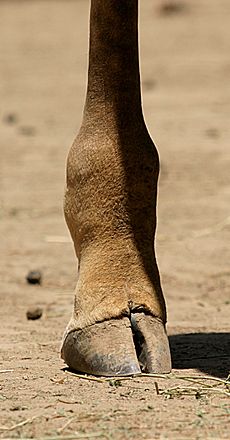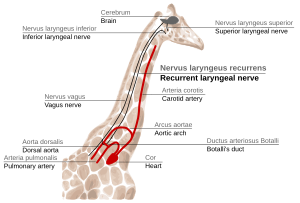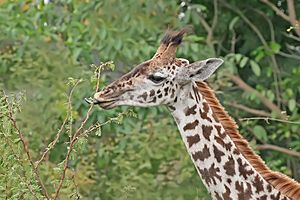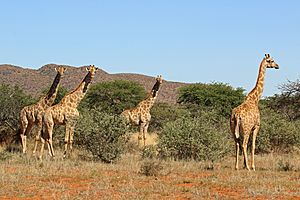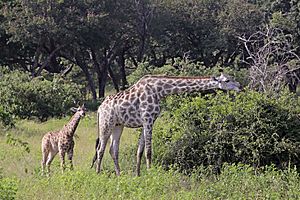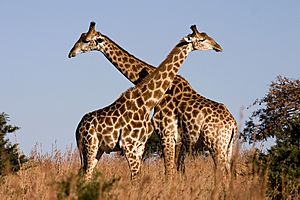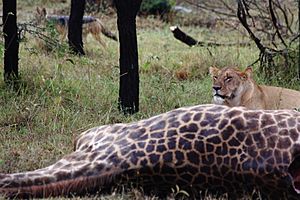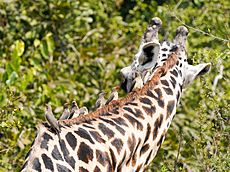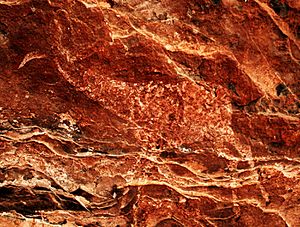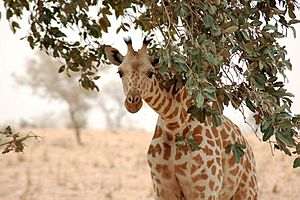Giraffe facts for kids
Quick facts for kids Giraffe |
|
|---|---|
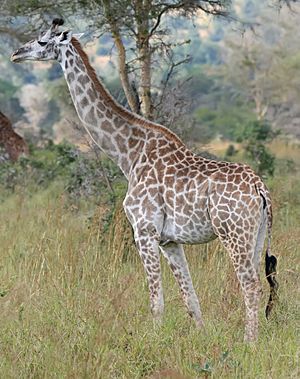 |
|
| Masai giraffe (G. c. tippelskirchi) in Mikumi National Park, Tanzania | |
| Conservation status | |
| Scientific classification | |
| Genus: |
Giraffa
|
| Species: |
camelopardalis
|
| Species | |
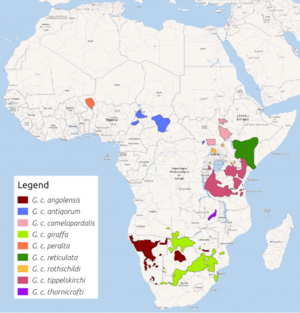 |
|
| Distribution of the giraffe | |
The giraffe is a very tall African mammal with hooves. It belongs to the group of animals called Giraffa. It is the tallest animal living on land and the biggest ruminant (an animal that chews its cud) on Earth. Scientists used to think there was only one species of giraffe, Giraffa camelopardalis, with nine different types called subspecies.
Recently, new studies of their DNA and body shapes suggest there might be up to eight different species of giraffes alive today. There are also seven other types of giraffes that are now extinct, known from old fossils.
Giraffes are easy to spot because of their super long necks and legs. They also have special horn-like bumps called ossicones and unique spotted coats. Their closest living relative is the okapi. Giraffes live in many parts of Africa, from Chad in the north to South Africa in the south. They usually live in savannahs and woodlands. They mostly eat leaves, fruits, and flowers from trees, especially acacia trees. They can reach food that other plant-eating animals can't.
Lions, leopards, spotted hyenas, and African wild dogs sometimes hunt giraffes. Giraffes live in groups of related females and their babies, or groups of adult males. They are social animals and can gather in large numbers. Male giraffes use their necks to fight and decide who is strongest. The strongest males get to mate with females. Female giraffes are the ones who raise the young.
People have always been fascinated by giraffes because of their unique look. They often appear in art, books, and cartoons. The International Union for Conservation of Nature (IUCN) says giraffes are vulnerable to extinction. This means their numbers are decreasing. They have disappeared from many areas where they used to live. In 2016, there were about 97,500 giraffes in the wild. More than 1,600 lived in zoos in 2010.
Contents
What's in a Name?
The word "giraffe" comes from the Arabic word zarāfah. This word might have come from a Persian word that means "flute-leg," possibly because of their long, thin legs. In old English, people used words like "jarraf" or "ziraph." The modern English word came from the French word girafe around the 1600s.
An older English name for the giraffe was "camelopard." This name comes from ancient Greek words for "camel" and "leopard." It describes their camel-like shape and leopard-like spots.
Amazing Giraffe Features
Adult giraffes are very tall, standing about 4.3 to 5.7 meters (14 to 19 feet) high. Males are usually taller than females. An average adult male weighs about 1,192 kg (2,628 lbs), and a female weighs about 828 kg (1,825 lbs). Even with their long necks and legs, their bodies are quite short. Their skin is mostly gray or tan and can be up to 20 mm (0.8 inches) thick. Their tail is 80 to 100 cm (31 to 39 inches) long and has a dark tuft of hair at the end, which they use to swat away insects.
Their coat has dark spots or patches that can be orange, brown, or almost black. These spots are surrounded by lighter hair, usually white or cream colored. Male giraffes' coats get darker as they get older. The spot patterns help them blend in with the light and shadows of the savannah trees. This makes them hard to see from a distance. Each giraffe has a unique coat pattern, like human fingerprints. Calves get some of their spot traits from their mothers. The skin under the spots may help control their body temperature.
Giraffe fur also has a special smell that helps keep parasites away. Males have a stronger smell than females.
Their Unique Head
Both male and female giraffes have horn-like structures called ossicones. These can grow up to 13.5 cm (5.3 inches) long. They are made of hardened cartilage covered in skin and attached to the skull. Ossicones help giraffes cool down and are used when males fight. You can tell a giraffe's sex or age by its ossicones. Females and young giraffes have thin ossicones with hair on top. Adult males have bald, bumpy ossicones. Older males also grow calcium bumps on their skulls, making their heads heavier for fighting.
Giraffes have large eyes on the sides of their heads, giving them a wide view from their great height. They can likely see in color, and their hearing and smell are very good. Their ears can move, and their nostrils are slit-shaped, possibly to keep out blowing sand. A giraffe's tongue is about 45 cm (18 inches) long and is black, maybe to protect it from sunburn. It's very flexible and can grasp leaves and twigs. Their upper lip is also flexible and hairy, protecting them from sharp thorns. They have a hard palate instead of front teeth on their upper jaw.
The Long Neck
The giraffe's neck is incredibly long, up to 2.4 meters (8 feet)! It has a mane of short, stiff hairs along it. The neck usually points up at a 50–60 degree angle. This long neck is not because they have more neck bones, but because each of their seven neck bones (vertebrae) is super long. Each one is over 28 cm (11 inches) long! These long neck bones make up more than half of the giraffe's spine. This lengthening mostly happens after birth, as it would be too hard for mothers to give birth to babies with such long necks.
Big muscles and a strong ligament (like a thick band of tissue) hold up the giraffe's head and neck. These are attached to long spines on their upper back bones, which create a hump.
Scientists have different ideas about why giraffes have such long necks. One idea, called the "competing browsers hypothesis," suggests that the long neck helps them reach food that other animals can't. Giraffes can eat leaves up to 4.5 meters (15 feet) high, while other large animals can only reach about 2 meters (6.5 feet). This gives giraffes an advantage, especially when food is scarce. However, some studies show that longer-necked giraffes might struggle more during droughts because they need more nutrients to maintain their necks.
Another idea is that long necks help male giraffes win fights to show who is strongest and get to mate with females. Males have longer and heavier necks than females of the same age, and they use their necks as weapons. But this doesn't fully explain why female giraffes also have long necks. Some also think the long neck helps them spot predators from far away.
Legs, Movement, and Rest
A giraffe's front and back legs are about the same length. Their hooves are large, up to 31 x 23 cm (12 x 9 inches) for big males, helping them support their great weight.
Giraffes have two main ways of moving: walking and galloping. When walking, they move both legs on one side of their body, then both legs on the other side. When galloping, their back legs swing around their front legs before the front legs move forward. They can run very fast, up to 60 km/h (37 mph) in a sprint, and can keep a speed of 50 km/h (31 mph) for several kilometers.
When a giraffe rests, it lies down with its body on its folded legs. To lie down, it kneels on its front legs and then lowers the rest of its body. To get up, it first gets on its front knees, then pushes its back end up, and finally stands its front legs straight. They swing their heads for balance during these movements. If a giraffe wants to drink water, it has to spread its front legs wide or bend its knees to reach the ground.
In zoos, giraffes sleep for about 4.6 hours a day, mostly at night. They usually sleep lying down. Sometimes, they bend their neck backward and rest their head on their hip or thigh for a deep sleep.
Inside the Giraffe's Body
The giraffe's body has special features to handle its height. For example, a nerve called the recurrent laryngeal nerve is over 2 meters (6.5 feet) long in giraffes, making it the longest in any living animal! This nerve starts in the brain, goes down the neck, and then loops back up to the voice box.
Despite its long neck and large head, a giraffe's brain is a normal size for an animal its type. Special cooling systems in its nose help keep its brain cool.
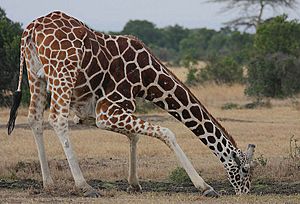
The giraffe's circulatory system (heart and blood vessels) is amazing. Its heart weighs about 11 kg (25 lbs) and is 60 cm (2 feet) long. It has to pump blood with about twice the pressure of a human heart to get blood all the way up to the brain. The heart's wall can be as thick as 7.5 cm (3 inches). When a giraffe lowers its head to drink, a special network of blood vessels in its neck prevents too much blood from rushing to its brain. When it raises its head, these vessels constrict to push blood back up, so the giraffe doesn't faint. The veins in its neck have valves that stop blood from flowing backward when the head is down. The skin on their lower legs is very thick and tight, which helps prevent too much blood from pooling there due to gravity.
Giraffes have strong muscles in their esophagus (food pipe) that allow them to bring food back up from their stomach to chew again, just like cows. They have four-chambered stomachs, which are perfect for their plant-based diet.
Life in the Wild
Where They Live and What They Eat
Giraffes usually live in open grasslands (savannahs) and woodlands. They especially like areas with acacia trees, which are a very important source of calcium and protein for them. They also eat shrubs, grass, and fruit. A giraffe eats about 34 kg (75 lbs) of plants every day. If they are stressed, they might chew on large branches and strip off the bark. They have also been seen chewing on old bones.
During the rainy season, there's plenty of food, so giraffes spread out. In the dry season, they gather around the evergreen trees and bushes that still have leaves. Like other ruminants, giraffes chew their food, swallow it, and then bring it back up to chew again. They need less food than many other plant-eaters because the leaves they eat are very nutritious, and their digestive system is very efficient. When they can find water, giraffes can go up to three days without drinking.
Giraffes have a big impact on the trees they eat. They can slow down the growth of young trees and create "waistlines" on taller trees. They eat most during the first and last hours of daylight. In between, they mostly stand and chew their cud. At night, they mostly lie down and chew their cud.
Social Life
Giraffes usually live in groups that can change in size and who is in them. Scientists used to think these groups were very loose and always changing. However, newer studies show that giraffes have long-lasting social groups or "cliques" based on family, sex, or other things. These smaller groups often meet up with other groups to form larger communities.
The number of giraffes in a group can be from one to as many as 66. Groups are often separated by sex, meaning all females or all males. But sometimes, you'll see mixed groups with adult females and young males. Female groups might be related to each other. Mothers and their young often form very stable groups that can last for weeks or months. Young males also form groups and have playfights. As males get older, they tend to be more solitary, but they might also hang out in pairs or with female groups.
Giraffes don't defend a specific territory, but they do have home ranges. These ranges change depending on how much rain there is and how close they are to human towns.
Early scientists thought giraffes were silent. But we now know they communicate using many sounds like snorts, sneezes, coughs, snores, hisses, moans, grunts, and flute-like sounds. Males make loud coughs during courtship. Females call their young by bellowing. Calves make bleating, mooing, and mewing sounds. Snorting and hissing mean they are alert to danger. At night, giraffes seem to hum to each other. They also use body language to communicate. Stronger males stand tall and stiff, showing their side to others. Less dominant giraffes show they are submissive by lowering their head and ears.
Reproduction and Life Cycle
Giraffes usually have a few older males that mate with many fertile females. Females can have babies all year round. They are ready to mate about every 15 days. Male giraffes roam around female groups to find mating opportunities. Males prefer young adult females.
A female giraffe is pregnant for 400–460 days. Usually, only one calf is born, but sometimes twins happen. The mother gives birth standing up. The calf comes out head and front legs first and falls to the ground, which breaks the umbilical cord. A newborn giraffe is already 1.7 to 2 meters (5.5 to 6.5 feet) tall! Within a few hours, the calf can run around. For the first one to three weeks, it mostly hides, using its spot pattern for camouflage. The ossicones, which were flat at birth, stand up in a few days.
Mothers with calves often gather in "nursery herds." Sometimes, mothers will leave their calves with one female while they go off to find food and water. This is called a "calving pool." Calves are at risk from predators. A mother giraffe will stand over her calf and kick at any approaching danger. Calves start chewing cud at four to six months old and stop drinking milk at six to eight months. Young giraffes might not become fully independent until they are 14 months old. Females can start having babies at four years old. Males need to wait until they are at least seven years old to have a chance to mate.
Necking: Male Giraffe Fights
Male giraffes use their long necks as weapons in fights, a behavior called "necking." Necking helps them decide who is the strongest male. Males who win these fights are more likely to mate. Necking can be low-intensity or high-intensity. In low-intensity necking, they rub and lean on each other. The one who stays more upright wins. In high-intensity necking, they spread their front legs and swing their necks at each other, trying to hit with their ossicones. They try to dodge blows and then hit back. The strength of a blow depends on the skull's weight and the swing's arc. A necking duel can last over half an hour. Most fights don't cause serious injuries, but sometimes jaws or necks can be broken, and even deaths have happened.
After a fight, it's common for two male giraffes to show affection to each other. These interactions between males are actually more common than mating between males and females.
Dangers and Health
Adult giraffes usually live a long time, up to 38 years, much longer than other animals that chew cud. Because of their size, good eyesight, and powerful kicks, adult giraffes are mostly safe from predators. Lions are their only major threat. Calves are much more vulnerable and are also hunted by leopards, spotted hyenas, and wild dogs. Only about a quarter to half of giraffe calves survive to adulthood. Calves born during the dry season tend to survive better.
When large herds of wildebeests and zebras are around, there's less danger for giraffe calves. Other animals might also benefit from being near giraffes, as giraffes can spot predators from far away due to their height. Zebras have been seen watching giraffes to assess danger and spend less time looking around when giraffes are present.
Giraffes can get parasites, especially ticks. Tick species like Hyalomma, Amblyomma, and Rhipicephalus often feed on giraffes. Giraffes might rely on red-billed and yellow-billed oxpecker birds to clean them of ticks and warn them of danger. Giraffes can also get various diseases and internal parasites. They can suffer from a skin problem that causes wrinkles and sores. In some areas, up to 79% of giraffes show signs of this disease, but it doesn't always cause death.
Cultural Importance
With their tall bodies and spotted coats, giraffes have always fascinated people. They are often seen as symbols of flexibility, foresight, grace, beauty, and the continent of Africa itself.
Giraffes appear in ancient African art, including works by the Kiffians, Egyptians, and Kushites. The Kiffians created a life-size rock carving of two giraffes 8,000 years ago, which is one of the world's largest rock art pieces. Many African folktales explain how the giraffe got its height. The Tugen people of Kenya even used the giraffe to represent their god. The ancient Egyptians had a special symbol (hieroglyph) for the giraffe.
Giraffes are also popular in modern Western culture. The artist Salvador Dalí painted giraffes with burning manes in his surrealist art. He saw the giraffe as a strong, masculine symbol. Many children's books feature giraffes, like The Giraffe Who Was Afraid of Heights and Giraffes Can't Dance. They have also appeared in animated movies like The Lion King and Madagascar. Sophie the Giraffe has been a popular baby toy since 1961, and Geoffrey the Giraffe was the mascot for Toys "R" Us.
Scientists have even studied giraffe skin to help design suits for astronauts and fighter pilots. This is because these suits need to prevent blood from rushing to the legs, similar to how a giraffe's body handles blood flow. The constellation of Camelopardalis (meaning "giraffe") in the sky was named in the 17th century.
Giraffes in Zoos
Ancient Egyptians were among the first to keep giraffes in captivity and sent them around the Mediterranean Sea. The Romans also collected and displayed giraffes. The first giraffe in Rome was brought by Julius Caesar in 46 BC. After the Roman Empire fell, keeping giraffes in Europe became less common. During the Middle Ages, Europeans learned about giraffes from Arabs, who admired the giraffe's unique look.
Some captive giraffes became very famous. In 1414, a giraffe from Malindi was taken to China by explorer Zheng He and put in a zoo. The Chinese people were fascinated by it and linked it to a mythical creature called the Qilin. The Medici giraffe was a gift to Lorenzo de' Medici in 1486 and caused a sensation in Florence. Zarafa, another famous giraffe, was brought from Egypt to Paris in the early 1800s as a gift for the French king. She became very popular, and many souvenirs were made in her image.
Giraffes are popular attractions in modern zoos. However, keeping them healthy is challenging because they need large spaces and lots of specific plants to eat. Giraffes in zoos sometimes show unusual behaviors like licking objects or pacing. Zookeepers try to keep them stimulated with various activities, including training them to take food from visitors. Giraffe enclosures in zoos are built very high to fit their tall bodies.
Conservation status
Sadly, giraffe populations are in trouble. In 2016, the IUCN declared the giraffe a Vulnerable species. The number of giraffes in the wild has dropped by about 40% in the last 30 years. There are now fewer than 100,000 giraffes left in Africa.
Threats
The biggest threats to giraffes are habitat loss and illegal hunting (poaching). As human populations grow, giraffes are losing the land they need to live and find food.
Giraffes have disappeared from many areas where they used to live, including Eritrea, Guinea, Mauritania, and Senegal. They might also be gone from Angola, Mali, and Nigeria.
Habitat destruction is a big problem for giraffes. In some areas, forests are cut down for firewood and to make space for livestock grazing. Giraffes can usually live alongside livestock because they eat leaves from higher up, avoiding direct competition. But severe droughts, like in northern Kenya in 2017, can lead to conflicts over land and the killing of wildlife, including giraffes.
Conservation efforts
Protected areas like national parks are very important for giraffes. They provide safe habitats and protection against poaching. Efforts by local communities outside national parks also help protect giraffes and their homes. Private game reserves in eastern and southern Africa have also helped preserve giraffe populations. The giraffe is a protected species in most of its range. It is the national animal of Tanzania, and killing one without permission can lead to imprisonment. In 2017, the United Nations-backed Convention of Migratory Species chose giraffes for protection. In 2019, giraffes were listed under CITES Appendix II, which means international trade in giraffes or their parts is now regulated.
Sometimes, giraffes are moved to new areas to help increase or re-establish populations that have shrunk or disappeared. However, these "translocations" are risky and difficult. Scientists use methods like aerial surveys (counting from planes) to track giraffe populations in large African areas. Ground surveys are more accurate and can be used with aerial surveys to get good estimates of how many giraffes there are.
See also
 In Spanish: Giraffa para niños
In Spanish: Giraffa para niños
- Fauna of Africa
- Giraffe Centre
- Giraffe Manor - a hotel in Nairobi where you can stay with giraffes



